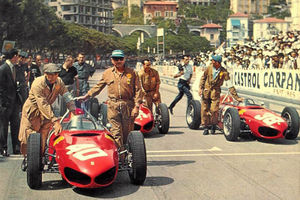User:Nikau/Lotus Cars
Lotus is a manufacturer of cars so British that they ram Union Jacks down the throats of bulldogs who can fart God Save the Queen. This is the official story, but no one would ever be dumb enough to believe there was a successful car industry in Britain.
All we are willing to say is that during their tenure as an F1 team, Lotus handed laughably advanced technology to men, one at a time, and expected them to overcome a conspiracy of national stereotypes and playboys with a desire for domination a little too ridiculous for words.
When the F1A reported that a mysterious organisation with British accents had made off with 6 World Drivers Championships, the officer on call just shrugged, gave them the number to MI5 and directed them to a very long queue under a sign. Complaints.
Origins[edit | edit source]
Most sporting equipment is best thought of as your typical male. A bat or a racket will be perfectly contented smacking a ball about all day, and doubly so if that is recorded on some official record for men to sit in rows and fuss over. If they could communicate, all the equipment would say is how they 'could of had' the ball if physics didn't sit down to pee.
However, given their tendency to leak at the most inopportune times (all times are inopportune to the men concerned) racing cars are very definitely female.
Ergo, 'having arms' is about all the resume you need to use a bat, but it takes a very special kind of man to control a Formula One car. Say, a man frequently known by a numeric code. A man who enjoys his Martini. Shaken, that is.
All we know is that during Lotus' long presence in Formula One, the essence of the machines transformed from an innocent front-engined roadster that would gasp at the terms used by the mechanics behind the garage, to an experienced monocoque, which would willingly take an engine up the backside if it meant an extra tenth on Sunday.
Philosophy[edit | edit source]
Despite sounding dangerously like a Slimfast slogan, the Lotus philosophy of car design was always focused on weight reduction, as opposed to power. Hence Lotus cars were rather fragile and given less protection than if they had spent a night with a another, more College-level, sports team.
Thus, while other teams concerned themselves with running engines that could rape Optimus Prime, a lighter car gave a driver the ability to slip past the front line using his cunning, and hubris often put pay to any opposition that was left.
The only thing Lotus loved more than removing things from cars, was adding things to them, and founder Colin Chapman was the kind of innovator Thomas Edison thought about when he had his hands down his pants.
Everything from the single-shell chassis, aerodynamic wings, and grip-creating under car vacuum channels originated from the mind of Colin Chapman and were put into practice by the Lotus mechanics; Even one with no knowledge of F1 must admit these sound like they could take out the better part of an Eastern bloc nation, so Lotus probably deserves credit for stopping modern F1 look like Herbie Goes Bananas with more scripted finishes.
1950s - The flower opens[edit | edit source]
Chapman founded Lotus in 1952 after a breif stint at British Aluminium, which is to say he had a fucking great time at University.
Early Lotus engineering turned out rudimentary kit cars that could be modified for any formulae or underground lair. The machines were barely large enough for a change of tuxedo, but the lightness meant it could be used for success in dangerous, unforgiving lands, such as Scotland.
The 1956 issue of Cat Fancier UK noted that the space frame chassis of the Lotus 7 was perfect for mounting some form of orbital death ray, and today the 7 roadster continues to hold great enthusiasm among bankers for track days and enslaving earth.
Joining F1[edit | edit source]
Chapman soon grew tired of all the brochures for volcano tours filling his letterbox, and seized upon an invitation to a baccarat game in Monte Carlo as a chance to break into Formula One by running a pair of Lotus' at the 1958 Grand Prix.
The Lotus founder found himself opposite Le Chiffre, a shady man with loose morals and an inordinate amount of money - and hence probably an FIA official, and Graham Hill, a young British playboy who totally didn't take that name from the first geographic feature he saw.
Hill found himself on the losing side of the game, and a sorry Chapman offered him a drive in the race. Hill would have won, had it not been for a kidnapping and bout of torture, while Le Chiffre died after an unfortunate case of being French.
By way of thanks Hill informed Chapman of a place where one could find daring men who would risk life and limb for Queen and trophy, before vanishing with a double entendre. This particular wing of the British establishment took particular interest in F1, given the Ferrari team identified with the colour red, and was headed by a bald man who enjoyed psychologically torturing his employees. Indeed, certain reports at the time cited the Ferrari factory at Maranello producing threats and loud whining 24 hours a day, as it still does now.
Success[edit | edit source]
Success was not instant, the team first had to take the cup from Jack Brabham, an 8 foot tall Australian with metal teeth. Brabham responded the way any Australian would when someone tries to take his cup and beat everyone senseless.
Indeed, Lotus' first victory was at the 1961 United States GP. Innes Ireland was able to pull back from 11th after a spin on oil and won by virtue of a failure in the engine of Stirling Moss' sister Lotus, caused when a satellite passed overhead. The wacky hazards and complete screw over of the leader later inspired a number of Nintendo games.
1960s - The flower blossoms[edit | edit source]
With strangely marked vans now parking outside his factory at all hours of the night, Chapman completed his next project. The Lotus 25, a car that revolutionized the F1 grid in the same way the guillotine revolutionized upper class France. Racing cars follow the basic principles of the 25 today. Probably out of fear.
The domination of the 25 between 1962 and 1965 was not all the car, though. The driver had to recline deeply behind the steering wheel, giving the car the nickname "bathtub". This all sounds a cucumber short of a spa now, however the cockpit sides were filled with rubber fuel cells that reached 70 degrees celcius, so the nickname was probably short for "bathtub full of angry fire crabs". One needed to have a history of sea-monster wrestling to even kick the tyres on this thing, so it was fortunate Lotus had Scotsman Jim Clark on call to drive when he wasn't testing reptile pressure points at Loch Ness.
Jim Clark[edit | edit source]
Everything Clark touched turned into gold. He would touch a car and two hours later be holding a massive golden trophy. For some reason Clark did not take to the nickname Goldfinger so kindly, though.
Had fate not intervened in 1968, Clark would have died of malnutrition, because all he drank was champagne. The only things that stood between Clark and the 25 winning every championship they competed in, were a bolt dislodged by a hat strike at the 1962 South African GP, and a miscalculation of fuel at the 1964 running that saw Clark wind up in in a Siberian missile facility. Both times Clark, ever the gentleman, thanked those responsible and blamed himself for "...Russian to the finish..."
Clark's run didn't end with the 25 either. If there was a single time in reality machines should have become sentient, it was to tell Jim Clark "holy fucking shit" after the 1967 Italian GP. Clark had raced out to a typically jaw dropping lead when a tyre blew, putting him down a lap. Passing the field twice is like being asked to escape your own cremation. Needless to say, he only finished third because of an unfortunate and unexplained detour through the canals of Venice.
Sadly, the Coventery Climax and then the Cosworth DFV were Tetris consoles first and engines second, preferring to drop funny shaped bits over the road than lap the field with Clark each week. Indeed, the official FIA statistics record a number of unusual retirements from "I expect you to DNF, Mr. Clark!" to "defector in the hydraulics".
This was an issue for Lotus, because Formula One wasn't some buddy cop film where one is partnered with a mustachioed womanizer you could call upon to drop some inexplicably good driving in the case of strife. Was it?
Graham Hill[edit | edit source]
Italy had to put guards around Casanova's grave during each Italian Grand Prix to make sure the 18th century lover didn't go asking Hill for dating tips. Back up from Hill would tear the dream centre right out of the brain of an average man, because nothing imagined would ever come close again.
On April 7th, 1968, when Clark's Lotus became air-born and disappeared into the trees somewhere near the East German border, Hill was there to hold the team together. Though bereft of the recognizable Scottish accent, Hill pulled Lotus to victory in 1968 thanks to the addition of ridiculous wings to his car and some underwater antics after winning in Monte Carlo.
Jochen Rindt[edit | edit source]
A plucky Austrian, Rindt had already won the 1965 24 Hours of Le Mans for an American team. Given the idea that drivers could share a car sounded dangerously communist, this was probably some form of semi-successful CIA infiltration.
Whatever Rindt's prior history, he stepped into Clark's former role and won off the bat, keeping on in the USA as others spun off into walls, piranha pits and the like. Although he did not finish his home Grand Prix after a 300km detour through a glacier field, Rindt was still classified in front of 150 Soviet winter commandos.
Jochen won the championship after being officially declared 'dead' at the 1970 Italian GP, much to the interest of prominent members in the 'fake mustache enthusiast' community of East Germany.
1970s - The flower has landed[edit | edit source]
By 1970, Chapman had the art of making stopwatches explode down pat. Case in point was the Lotus 56, a car powered by a fucking gas turbine. The 56 was not so successful on track, because it spent most of its time off track harassing itinerant space stations.
Emerson Fittipaldi[edit | edit source]
The flower is taken over by that giant plant that smells like a dick[edit | edit source]
Lotus was liquidated in a move that couldn't have been more of a blow for British morale had there been a clause stippulating that the Queen must get socked in the face. Don't worry though, the deep British heritage of Lotus was perfectly respected when it was purchased by Pacific, a team named after an ocean several thousand miles away from the British isles.
The name was apt, because an ocean is the largest body of water you could dump a car as bad as Pacific's 1995 offering and hope to never see it again.
Conclusion[edit | edit source]
The company that had started by manufacturing cars for wealthy men to pretend to be racing drivers, had ended its life manufacturing cars for wealthy men who wished to be racing drivers, only the mid 1990s version were indistinguishable from wasted streakers who disrupt sports games on a dare from those down at the local.


